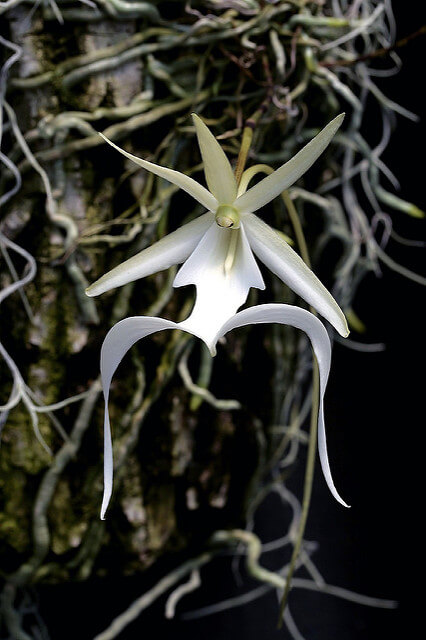Some people spend their entire lives searching for the Ghost Orchid. It is a very rare plant that is on the endangered species list. Native to Southwest Florida and Cuba, the Ghost Orchid is believed to have only 100 or so plants still in existence. The locations of these orchids are kept secret to prevent poachers from continuing to take them from their natural environment.
At this time, it is illegal to remove a Ghost Orchid from the wild. The Ghost Orchid declined because of poaching, and because of Florida’s draining of swampland and removal of cypress trees.
The Ghost Orchid is located in one very specific area in Florida, the swamps in Fakashatchee, Big Cypress, and Corkscrew areas of Hendry and Collier counties. The one exception to keeping the location of the Ghost Orchid secret is one that was discovered in the swamp at Corkscrew in 2007. It is visible from a public boardwalk through the Corkscrew area and has blossomed in both the summers of 2007 and 2008. Thousands of visitors have entered this protected area to view the plant.
The Corkscrew Ghost Orchid is growing up the trunk of a Bald Cypress tree that is believed to be between 400-500 years old. It is around fifty feet above ground on the tree. Previously, the highest recorded Ghost Orchid was 23 feet at the Fakahatchee preserve.

From NC Orchid
Experts believe this Ghost Orchid plant to be between thirty and thirty-five years old. In the three times it has bloomed 2007 this Ghost Orchid has had 12, 10, and 3 blooms at the same time respectively. Ghost Orchids do not bloom every year and can go many years with no flowers at all. In June of 2008, it had five flowers.
The Ghost Orchid can only reproduce by being pollinated by the Giant Sphinx Moth. The moth is huge–each wing can measure up to five inches across. It is the only insect with a proboscis long enough to reach into the plant to retrieve the pollen. The proboscis of the Giant Sphinx Moth can be up to six inches long. If you do an internet search for “giant sphinx moth + ghost orchid,” you can find the first ever photos of the moth pollinating the plant. It was all caught on video in 2007. Until then it was assumed the Giant Sphinx Moth was the pollinator but it had never been absolutely confirmed.
Once pollinated, the Ghost Orchid grows a long seed pod which eventually opens up, leaving the wind to scatter the seeds. The plant requires the presence of one particular fungus for a seed to germinate.
Jean Jules Linden was the first person to discover the Ghost Orchid in Cuba. The year was 1844 and the plant received its scientific name, Dendrophylax lindenii from the its discoverer. The name Ghost Orchid was given to the plant because it has no leaves, which makes it look like the flower is sitting in mid-air. The white flowers are four to five inches across.
The Ghost Orchid is also sometimes called the “frog orchid,” because its two bottom flowers hang downward looking very much like the back legs of a frog.
The Ghost Orchid plant has several more unique characteristics. It is considered epiphytic, which means that it grows on other plants but it never uses any of the nutrients of the other plant. Because it has no leaves, photosynthesis occurs through the plant’s roots. The two most common trees the Ghost Orchid uses as a base are the pop ash and the pond apple. Others include the bald cypress, oak, and maple.
Many people who are not particularly interested in plants or flowers are familiar the Ghost Orchid, at least by name, as it was the title of a novel by Susan Orleans. The novel was based on the true story of a plant collector who was arrested after stealing a Ghost Orchid plant from the wild, with which to propagate others to make money. The thing is, ninety-nine percent of the time a wild Ghost Orchid plant dies in captivity.